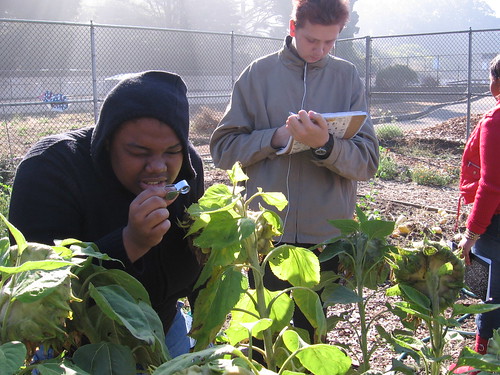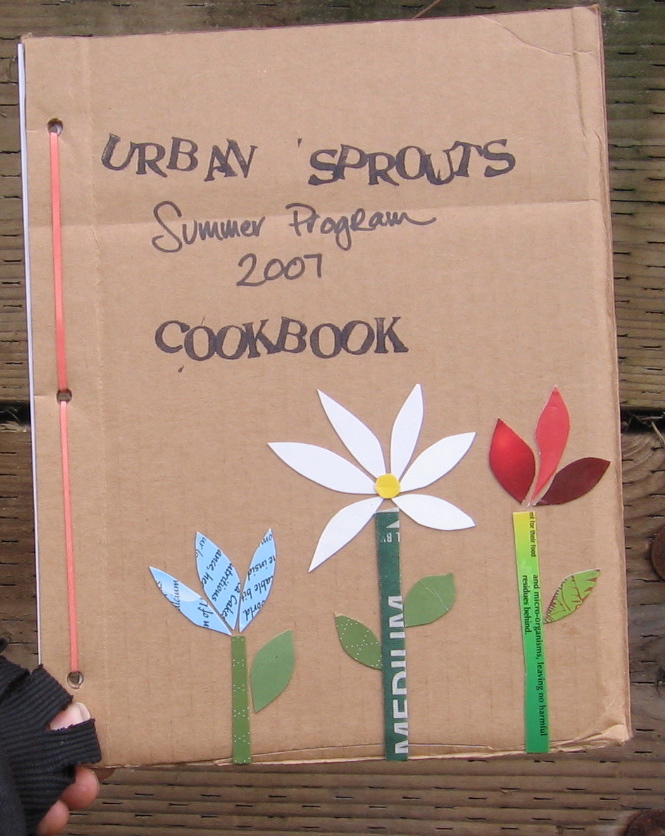You may have seen in your community that more and more children cope with adult health problems, like diabetes, high blood pressure and heart disease.
How can we allow this epidemic to touch our children? At the four San Francisco public schools where Urban Sprouts works, 50% of youth are overweight and 93% are considered unfit, according to state fitness standards. That is more than double the rate of overweight youth in the rest of San Francisco.
This astonishes me. Too many of the bright, opinionated and spunky youth I see every day at school are not getting the nutrition and daily exercise they need to grow strong and live long, healthy, and happy lives. And they are unfairly affected more than their peers from wealthier neighborhoods!
Everyday, in San Francisco, Urban Sprouts is helping urban youth to give their peers a different choice: fresh, healthy organic food grown right at their own schools. By nurturing living plants, harvesting and eating fresh fruits and vegetables, youth are nourishing their bodies and cultivating a commitment to healthy living.
This is why I’m urging you, right now, to click the “Donate Now” button above and make a donation of $35, $50, or $100. Your support for Urban Sprouts will make a meaningful difference.
 By supporting Urban Sprouts, you’ll be providing school gardens where youth can connect deeply with peers, adults and the natural world, and eat veggies that taste of accomplishment and community, as well as good health.
By supporting Urban Sprouts, you’ll be providing school gardens where youth can connect deeply with peers, adults and the natural world, and eat veggies that taste of accomplishment and community, as well as good health.Like me, you may notice the many teens who stop at mini marts on the way to school every morning and buy bags of neon red hot chips and super sized sweet drinks. Urban Sprouts seventh graders studied the nutrition facts on snacks and scooped the 25 teaspoons of sugar contained in one drink into a baggie to examine. We contemplated teenage depression and mood swings compounded by eating mass amounts of sugar.
Then, we went outside to the garden. The students dug their shovels into garden soil, using their strength to mix in nourishing compost, stopping only to admire graceful butterflies and wiggling worms. After 15 minutes we all stopped to take our pulses. Our hearts were beating at the recommended level for teens’ daily exercise. Whew! That felt amazingly good.
Urban Sprouts uses garden-based education to help urban youth make sense of the mixed messages they get from TV, parents, celebrities and peers about what to eat and why. When youth make educated choices about eating they have the power to resist media and marketing pressure and to live in a way that truly feels good.
I know you care about these issues as much as I do. That’s why I'm asking you for your help today. I want to offer you the chance to join the Urban Sprouts community yourself, as a donor and supporter.
 Urban Sprouts was founded in 2003 by teachers from Luther Burbank Middle School and volunteers from the community who wanted to make a difference. Since then, over 450 youth have worked, played and explored in the garden. We’ve expanded to reach over 450 youth each year at four public schools: June Jordan School for Equity, Ida B. Wells Continuation High School, Martin Luther King, Jr. Middle School, and the Small Middle School for Equity (formerly Burbank).
Urban Sprouts was founded in 2003 by teachers from Luther Burbank Middle School and volunteers from the community who wanted to make a difference. Since then, over 450 youth have worked, played and explored in the garden. We’ve expanded to reach over 450 youth each year at four public schools: June Jordan School for Equity, Ida B. Wells Continuation High School, Martin Luther King, Jr. Middle School, and the Small Middle School for Equity (formerly Burbank).You’ll be interested to know that Urban Sprouts is uniquely designed to support urban middle and high schools serving disadvantaged youth. At Urban Sprouts schools, over 60% of youth are from low-income families and over 95% are youth of color.
These are the schools most in need of school gardens: in San Francisco, only 15% of school gardens serve middle or high school youth and 30% of school gardens belong to economically disadvantaged schools. That’s why our model is so crucial, for youth here and in other cities.
Urban Sprouts’ four areas of impact are:
❋ Health and NutritionUrban Sprouts supports urban schools using a four-tiered approach:
❋ Ecoliteracy & Eco-Actions
❋ Academic Performance
❋ Youth Development
❋ Garden-based science class: Over 450 students experience hands-on lessons in environmental science and nutrition, garden work, and cooking, led by our Garden Educators with teachers and volunteers.
❋ Research-tested curriculum: Results of our evaluation research already show that students recognize, prefer and choose to eat more vegetables after Urban Sprouts’ lessons. Our research partners are Tufts University and UC Berkeley.
❋ Family Connections: Urban Sprouts is piloting a new approach to low parent involvement in struggling urban middle schools. We’re using the school garden to engage families and help them improve the school through greening, healthy food, and more.
❋ A Model to help other urban middle and high schools: The results of our research will help other urban middle and high schools replicate our program.
 After only three years, the response to Urban Sprouts is inspiring. School principals tell us the growing garden brings a sense of pride, beauty, and meaning to the gray and bleak urban setting of their schools. Teachers tell us the cooperation, leadership and self-confidence of students in the garden brings tears to their eyes. Students tell us they’ve started asking their parents to cook special family meals with garden fresh ingredients.
After only three years, the response to Urban Sprouts is inspiring. School principals tell us the growing garden brings a sense of pride, beauty, and meaning to the gray and bleak urban setting of their schools. Teachers tell us the cooperation, leadership and self-confidence of students in the garden brings tears to their eyes. Students tell us they’ve started asking their parents to cook special family meals with garden fresh ingredients.The community connections that grow from the garden are the most nourishing and meaningful results of all. We want you to join us! By giving to Urban Sprouts right now, you will make an investment in the healthy future of our youth and our communities, and you get to be a part of school gardens, today!
 Please join us today! CLICK HERE to DONATE NOW and give your gift of $35, $50 or $100.
Please join us today! CLICK HERE to DONATE NOW and give your gift of $35, $50 or $100.Thank you very much.
Warm wishes to you,
Abby R. Jaramillo
Executive Director
abby AT urbansprouts DOT org
P.S. We need you! In addition to your gift, we invite you to the garden, to mentor students during the day, help with garden building projects, or to serve on our board. EMAIL ME to get involved!
P.P.S. Our fiscal sponsor, Urban Resource Systems, Inc, accepts online gifts on our behalf. When you click the "Donate Now" button you'll see URS's name, but your gift will be designated for Urban Sprouts' programs. Thanks!











